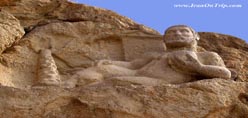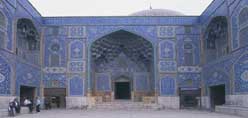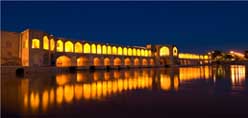Persepolis

Persepolis herself capital of the mighty Persian Empire stands on the celebrated
site of an Achaemenian palace built 2,500 years ago by Darius the Great, with
wonderfully preserved rock reliefs and columns on a spectacular terrace.
Persepolis is the most impressive of all archaeological sites in Iran, because of
its size and the nature of the ruins which display some of the finest examples of
carving to be seen from ancient world. At its height the Persian Empire
stretched from Greece and Libya in the west to the Indus River in present-day
Pakistan in the east. The Persian kings used Persepolis primarily as a residence
and for ceremonies such as the New Year’s celebration (Nowrooz). Each year,
at Nowrooz (the national festival of the vernal equinox) representatives from
all nations of the Persian Empire brought tribute to the king. Persepolis consists
of the remains of several monumental buildings on a vast artificial stone terrace:
The Apadana palace, the earliest and grandest of all palaces of Persepolis. It was
the great audience hall where the king received delegations from the vassal
nations. The magnificent Eastern Staircase of the Apadana has a carving 23
delegations from subject nations of the Persian Empire in almost pictographic
detail, bearing tribute to the Persian king.The palace of Darius: The Tachara,
or winter palace, was used by the king during the celebrations.
It had red floor and doorways decorated by imaginary creatures in battle with
king or scenes of him being tended by attendants holding a fly whisk and a
parasol.The gate of all nations : The gate was made of the time of Xerxes to
allow delegates to rest and wait their turn for audience with the king. The
gateways are decorated with guardians bulls, above which trilingual inscription
by Xerxes also appears on each side.The Palace of Xerxes : The Hadish or the
palace of Xerxes is three times size of that Darius’s with a similar setting.
It overlooks the palace of Artaxerxes and the Harem.The hall of hundred
columns .: Also called the Throne hall was the biggest covered area in Persepolis.
It is fronted by a portico on the Northern side from which side the palace was
approached. Carvings of one thundered immortal guards in combat gear on each
side of the gateway provide decoration with the king enthroned at the top and the
master of ceremony reporting.Persepolis was destroyed two centuries after it was
begun by Alexander of Macedonia. Seized and burned by Alexander army, eroded
by centuries long exposure to elements and earthquakes, Still Persepolis the
greatest palatial complex of Persia, remains as one of the most striking wonder
of ancient world.
The ruins of Persepolis; the ceremonial capital of the Achaemenid Empire

The Achaemenid Persian empire (550–330 B.C.) was the largest that the ancient world had seen, extending from Anatolia and Egypt across western Asia to northern India and Central Asia. Its formation began in 550 B.C., when King Astyages of Media, who dominated much of Iran and eastern Anatolia (Turkey), was defeated by his southern neighbor Cyrus II ("the Great"), king of Persia (r. 559–530 B.C.). This upset the balance of power in the Near East. The Lydians of western Anatolia under King Croesus took advantage of the fall of Media to push east and clashed with Persian forces.
The Lydian army withdrew for the winter but the Persians advanced to the Lydian capital at Sardis, which fell after a two-week siege. The Lydians had been allied with the Babylonians and Egyptians and Cyrus now had to confront these major powers. The Babylonian empire controlled Mesopotamia and the eastern Mediterranean. In 539 B.C., Persian forces defeated the Babylonian army at the site of Opis, east of the Tigris. Cyrus entered Babylon and presented himself as a traditional Mesopotamian monarch, restoring temples and releasing political prisoners. The one western power that remained unconquered in Cyrus' lightning campaigns was Egypt. It was left to his son Cambyses to rout the Egyptian forces in the eastern Nile Delta in 525 B.C. After a ten-day siege, Egypt's ancient capital Memphis fell to the Persians.
A crisis at court forced Cambyses to return to Persia but he died en route and Darius I ("the Great") emerged as king (r. 521–486 B.C.), claiming in his inscriptions that a certain "Achaemenes" was his ancestor. Under Darius the empire was stabilized, with roads for communication and a system of governors (satraps) established. He added northwestern India to the Achaemenid realm and initiated two major building projects: the construction of royal buildings at Susa and the creation of the new dynastic center of Persepolis, the buildings of which were decorated by Darius and his successors with stone reliefs and carvings.
These show tributaries from different parts of the empire processing toward the enthroned king or conveying the king's throne. The impression is of a harmonious empire supported by its numerous peoples. Darius also consolidated Persia's western conquests in the Aegean.
However, in 498 B.C., the eastern Greek Ionian cities, supported in part by Athens, revolted. It took the Persians four years to crush the rebellion, although an attack against mainland Greece was repulsed at Marathon in 490 B.C.
Darius' son Xerxes (r. 486–465 B.C.) attempted to force the mainland Greeks to acknowledge Persian power, but Sparta and Athens refused to give way. Xerxes led his sea and land forces against Greece in 480 B.C., defeating the Spartans at the battle of Thermopylae and sacking Athens. However, the Greeks won a victory against the Persian navy in the straits of Salamis in 479 B.C. It is possible that at this point a serious revolt broke out in the strategically crucial province of Babylonia. Xerxes quickly left Greece and successfully crushed the Babylonian rebellion. However, the Persian army he left behind was defeated by the Greeks at the Battle of Plataea in 479 B.C.
Much of our evidence for Persian history is dependent on contemporary Greek sources and later classical writers, whose main focus is the relations between Persia and the Greek states, as well as tales of Persian court intrigues, moral decadence, and unrestrained luxury. From these we learn that Xerxes was assassinated and was succeeded by one of his sons, who took the name Artaxerxes I (r. 465–424 B.C). During his reign, revolts in Egypt were crushed and garrisons established in the Levant.
Achaemenid golden bowl with lion imagery
The empire remained largely intact under Darius II (r. 423–405 B.C), but Egypt claimed independence during the reign of Artaxerxes II (r. 405–359 B.C). Although Artaxerxes II had the longest reign of all the Persian kings, we know very little about him. Writing in the early second century A.D., Plutarch describes him as a sympathetic ruler and courageous warrior. With his successor, Artaxerxes III (r. 358–338 B.C), Egypt was reconquered, but the king was assassinated and his son was crowned as Artaxerxes IV (r. 338–336 B.C.). He too was murdered and replaced by Darius III (r. 336–330 B.C.), a second cousin, who faced the armies of Alexander III of Macedon ("the Great"). Ultimately Darius III was murdered by one of his own generals and Alexander claimed the Persian Empire. However, the fact that Alexander had to fight every inch of the way, taking every province by force, demonstrates the extraordinary solidarity of the Persian Empire and that, despite the repeated court intrigues, it was certainly not in a state of decay.
(Source: metmuseum.org)
.....
.....
.....

.jpg)



























